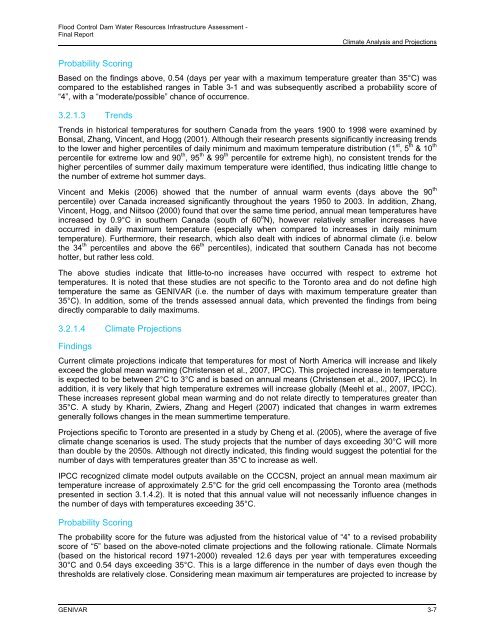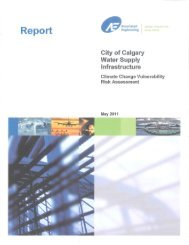Final Report - Vulnerability Committee
Final Report - Vulnerability Committee
Final Report - Vulnerability Committee
Create successful ePaper yourself
Turn your PDF publications into a flip-book with our unique Google optimized e-Paper software.
Flood Control Dam Water Resources Infrastructure Assessment -<strong>Final</strong> <strong>Report</strong>Climate Analysis and ProjectionsProbability ScoringBased on the findings above, 0.54 (days per year with a maximum temperature greater than 35°C) wascompared to the established ranges in Table 3-1 and was subsequently ascribed a probability score of“4”, with a “moderate/possible” chance of occurrence.3.2.1.3 TrendsTrends in historical temperatures for southern Canada from the years 1900 to 1998 were examined byBonsal, Zhang, Vincent, and Hogg (2001). Although their research presents significantly increasing trendsto the lower and higher percentiles of daily minimum and maximum temperature distribution (1 st , 5 th & 10 thpercentile for extreme low and 90 th , 95 th & 99 th percentile for extreme high), no consistent trends for thehigher percentiles of summer daily maximum temperature were identified, thus indicating little change tothe number of extreme hot summer days.Vincent and Mekis (2006) showed that the number of annual warm events (days above the 90 thpercentile) over Canada increased significantly throughout the years 1950 to 2003. In addition, Zhang,Vincent, Hogg, and Niitsoo (2000) found that over the same time period, annual mean temperatures haveincreased by 0.9°C in southern Canada (south of 60 o N), however relatively smaller increases haveoccurred in daily maximum temperature (especially when compared to increases in daily minimumtemperature). Furthermore, their research, which also dealt with indices of abnormal climate (i.e. belowthe 34 th percentiles and above the 66 th percentiles), indicated that southern Canada has not becomehotter, but rather less cold.The above studies indicate that little-to-no increases have occurred with respect to extreme hottemperatures. It is noted that these studies are not specific to the Toronto area and do not define hightemperature the same as GENIVAR (i.e. the number of days with maximum temperature greater than35°C). In addition, some of the trends assessed annual data, which prevented the findings from beingdirectly comparable to daily maximums.3.2.1.4 Climate ProjectionsFindingsCurrent climate projections indicate that temperatures for most of North America will increase and likelyexceed the global mean warming (Christensen et al., 2007, IPCC). This projected increase in temperatureis expected to be between 2°C to 3°C and is based on annual means (Christensen et al., 2007, IPCC). Inaddition, it is very likely that high temperature extremes will increase globally (Meehl et al., 2007, IPCC).These increases represent global mean warming and do not relate directly to temperatures greater than35°C. A study by Kharin, Zwiers, Zhang and Hegerl (2007) indicated that changes in warm extremesgenerally follows changes in the mean summertime temperature.Projections specific to Toronto are presented in a study by Cheng et al. (2005), where the average of fiveclimate change scenarios is used. The study projects that the number of days exceeding 30°C will morethan double by the 2050s. Although not directly indicated, this finding would suggest the potential for thenumber of days with temperatures greater than 35°C to increase as well.IPCC recognized climate model outputs available on the CCCSN, project an annual mean maximum airtemperature increase of approximately 2.5°C for the grid cell encompassing the Toronto area (methodspresented in section 3.1.4.2). It is noted that this annual value will not necessarily influence changes inthe number of days with temperatures exceeding 35°C.Probability ScoringThe probability score for the future was adjusted from the historical value of “4” to a revised probabilityscore of “5” based on the above-noted climate projections and the following rationale. Climate Normals(based on the historical record 1971-2000) revealed 12.6 days per year with temperatures exceeding30°C and 0.54 days exceeding 35°C. This is a large difference in the number of days even though thethresholds are relatively close. Considering mean maximum air temperatures are projected to increase byGENIVAR 3-7








